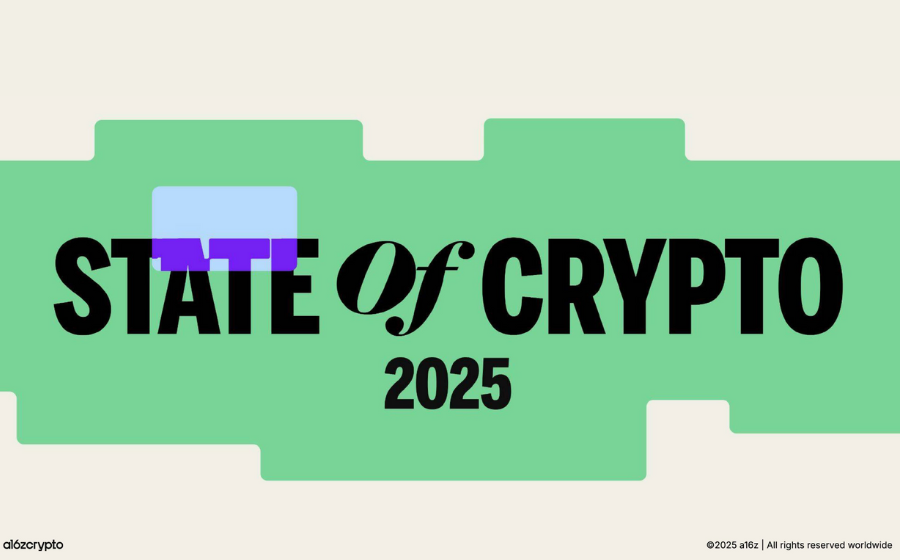
KEYTAKEAWAYS
- Crypto reached mainstream adoption in 2025, surpassing $4T market cap, driven by institutional inflows, stablecoins, and regulatory clarity.
- In 2025, blockchain innovation, AI integration, and global adoption propelled crypto from speculation to a core pillar of the digital economy.
- Institutions, stablecoins, and real-world assets fueled crypto’s 2025 growth, marking its transition into global finance and everyday payments.

- KEY TAKEAWAYS
- Market Overview: Resilience and Growth in Tandem
- Institutional Adoption Accelerates: Breaking Critical Mass
- The Rise of Stablecoins: Pillars of the Payment System
- Global Adoption Wave: From Emerging Markets to Everyday Penetration
- Emerging Trends and Innovations: AI, RWAs, and More
- Future Outlook: A Developer-Led Growth Cycle
- DISCLAIMER
- WRITER’S INTRO
CONTENT

References:
This article is based on Andreessen Horowitz (a16z)’s State of Crypto 2025 report, real-time market data from CoinMarketCap and CoinGecko, and Chainalysis’s global adoption report. Data as of October 23, 2025; prices and metrics are approximations subject to market fluctuations. Full citations are marked inline.
As of October 23, 2025, the cryptocurrency ecosystem has reached unprecedented maturity, transitioning from early speculative frenzy to integral components of global finance, technology, and daily life. Andreessen Horowitz (a16z)’s just-released State of Crypto 2025 report captures this shift perfectly, declaring 2025 “the year crypto went mainstream.”
With total market capitalization surpassing $4 trillion for the first time, institutional inflows accelerating, and stablecoins outpacing traditional payment networks, crypto is no longer a niche asset—it’s a foundational layer of the digital economy. This overview draws on the latest data, trends, and market sentiment to highlight why 2025 marks the tipping point for mass adoption.
Market Overview: Resilience and Growth in Tandem
In 2025, the crypto market has demonstrated remarkable resilience and growth momentum, fueled by regulatory tailwinds, technological advancements, and macroeconomic factors such as U.S. interest rate cuts and pro-crypto policies under the Trump administration. Bitcoin’s dominance holds steady at around 50%, solidifying its role as a store of value, while altcoins like Ethereum and Solana drive innovation in DeFi and AI-integrated applications. As of mid-October, the total market cap stands at approximately $4.24 trillion.
Bitcoin trades around $124,000, up 2.5% in the last 24 hours, with a market cap of about $2.45 trillion; it hit a high of $126,000 earlier this year and is up 29% year-to-date, driven primarily by institutional buying. Ethereum is at roughly $4,047, up 4.0% over 24 hours, with a $486 billion market cap—as the DeFi hub, its Layer 2 solutions like Base and Optimism have seen 78% developer growth.
Solana hovers near $193, up 3.6%, with a $100 billion market cap; its decentralized exchange (DEX) volume reached $94.8 billion, surpassing Ethereum, and total value locked (TVL) has grown over 300% since 2024. BNB is around $1,123, up 3.4%, with a $163 billion market cap, thriving in the Binance ecosystem as a key pillar for cross-chain DeFi. These figures are approximations from recent market snapshots, but rapid price fluctuations underscore the market’s vitality.
Bitcoin’s surge to new highs has been powered by ETF inflows exceeding $70 billion year-to-date, while Ethereum’s Pectra upgrade has boosted scalability, attracting developers and dApps in gaming, AI, and real-world assets (RWAs). Market consensus holds that 2025 is the year crypto went mainstream: governments have stopped fighting it, and Wall Street has realized it must play along.
Institutional Adoption Accelerates: Breaking Critical Mass
Institutional adoption has hit critical mass, with exchange-traded products (ETPs) holding over $175 billion in Bitcoin and Ethereum assets—up 169% from last year. BlackRock’s iShares Bitcoin Trust (IBIT) has become the most traded Bitcoin ETP launch ever, while firms like Fidelity, JPMorgan, and Visa have rolled out crypto custody, trading, and payment products. Publicly traded “digital asset treasury” companies now hold 4% of circulating Bitcoin and Ethereum, with ETPs and these firms combined controlling about 10% of supplies.
Stripe’s acquisition of stablecoin platform Bridge and Circle’s $1 billion IPO signal traditional finance’s full embrace. State Street predicts spot ETFs for the top 10 coins by year-end, potentially surpassing precious metals ETFs.
This capital influx has decoupled DeFi from centralized exchanges, with perpetuals platforms like Hyperliquid generating over $1 billion in annualized revenue. Market sentiment is buoyant, with institutions like BlackRock and Galaxy Digital leading a flood of capital into Bitcoin and Ethereum.
The Rise of Stablecoins: Pillars of the Payment System
Stablecoins have emerged as the backbone of mainstream payments, processing $46 trillion in annual volume—nearly three times Visa’s and on par with ACH. Adjusted volume hit a record $1.25 trillion in September, up 87% year-over-year, with supply exceeding $300 billion (87% from USDT and USDC). Stablecoins hold over $150 billion in U.S. Treasuries (ranked #17 globally), bolstering dollar hegemony.
Projections point to 10x growth to $3 trillion by 2030. The passage of the GENIUS Act has provided regulatory clarity, enabling banks and fintechs like PayPal and Shopify to integrate stablecoins into everyday use. Market observations show crypto’s mainstreaming: in 2025, Bitcoin, Ethereum, and XRP are accepted for everything from luxury goods to flights.
Global Adoption Wave: From Emerging Markets to Everyday Penetration
Global adoption is accelerating from emerging markets to routine use. On-chain active users range from 40-70 million (up 10 million year-over-year), with wallet users at all-time highs (up 20%). Adoption in emerging markets has surged—Argentina’s mobile wallets grew 16x in three years—driven by inflation hedging (usage rose from 29% to 46% in Q2).
Top countries for adoption from January to July include India, the US, Pakistan, the Philippines, and Brazil. North America accounts for 26% of global transaction value ($2.3 trillion from July 2024 to June 2025), while APAC on-chain activity rose 69% year-over-year. Over 560 million global users (about 7% of humanity) signal near-mainstream status, with 15-20% projected by 2030.
Emerging Trends and Innovations: AI, RWAs, and More
Emerging trends are reshaping the landscape. The tokenized RWAs market has reached $30 billion (up 4x in two years), with DePIN projected to hit $3.5 trillion by 2028. The fusion of AI and crypto is spawning decentralized models and agents (e.g., the x402 protocol), which have verified over 17 million identities; AI memecoins and agents dominate narratives.
In gaming and NFTs, Solana gaming tokens are surging, and NFT buyers are shifting toward collecting (monthly actives up). On privacy and scalability, transactions per second (TPS) have risen 100x to 3,400; zero-knowledge proofs and post-quantum crypto are gaining traction. Memecoin launches are down 56%, with focus shifting to utility. Market predictions abound, such as Bitcoin reaching $140,000-$250,000 and tokenized assets hitting $2 trillion.
Future Outlook: A Developer-Led Growth Cycle
Looking ahead, 2025’s regulatory wins (e.g., the CLARITY Act) and infrastructure leaps pave the way for a “builder-led” cycle, though macro risks like quantum threats to Bitcoin security remain. Analysts forecast Bitcoin in the $80,000-$151,000 range (with higher upside potential), Ethereum at $15,000, and Solana sustainably breaking $200.
Market consensus is clear: in 2025, the world has finally gone on-chain. Stablecoins processed over $46 trillion. Active users exceed 70 million. Institutional adoption has gone fully mainstream. The infrastructure is in place—now it’s about scaling users and use cases. Crypto isn’t just surviving; it’s reshaping the world. Volatility persists, but the trajectory is undeniably upward—stay vigilant and press on.















